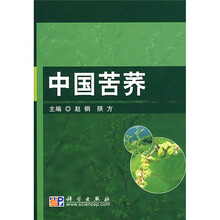农林类研究生教材系列:中国苦荞

目 录内容简介
目录序前言第一章 苦荞概述 1第一节 苦荞生产的重要意义 1第二节 中国苦荞的分布与生产 4第三节 苦荞的开发与应用 7参考文献 9第二章 苦荞的生物学特性 11第一节 苦荞的根 11第二节 苦荞的茎 15第三节 苦荞的叶 18第四节 苦荞的花和花序 22第五节 苦荞的果实 27第六节 苦荞的花粉粒 31第七节 苦荞的生长发育 33参考文献 48第三章 苦荞的起源进化与分布 49第一节 苦荞的分类地位 49第二节 苦荞的起源、进化与传播 51第三节 中国苦荞的分布 57参考文献 61第四章 苦荞种质资源与遗传育种 64第一节 中国苦荞种质资源的搜集、整理和保存 64第二节 苦荞的优异种质资源 71第三节 苦荞的细胞遗传学基础 73第四节 苦荞的同工酶 76第五节 苦荞遗传育种 80第六节 苦荞的良种繁育 99参考文献 105第五章 苦荞栽培技术 107第一节 苦荞的种植制度 107第二节 苦荞田的土壤耕作与整地 109第三节 苦荞地施肥 111第四节 苦荞的播种技术 123第五节 苦荞的合理密植 128第六节 苦荞的田间管理 133第七节 苦荞收获与储存 140第八节 苦荞绿色有机种植技术 141参考文献 144第六章 苦荞营养保健活性成分 145第一节 苦荞的营养学评价 145第二节 蛋白质与多肽 152第三节 酚类与生物黄酮 158第四节 荞麦糖醇 163参考文献 170第七章 苦荞黄酮的分离与研究 173第一节 苦荞生物黄酮的化学组成及其理化性质 173第二节 苦荞生物黄酮的提取方法 178第三节 苦荞麦生物黄酮的分离与纯化方法 181第四节 苦荞黄酮浸出液的浓缩与干燥 184第五节 苦荞生物黄酮的定性、定量检查与结构鉴定 186第六节 黄酮类化合物的吸收、分布和代谢 193第七节 苦荞黄酮应用举例 196参考文献 197第八章 苦荞药理及临床研究 199第一节 苦荞药用成分及药理作用 199第二节 苦荞临床研究 211第三节 苦荞食疗及验方 214参考文献 221第九章 苦荞营养保健食品生产与开发 225第一节 苦荞传统食品加工工艺 225第二节 苦荞新型食品的生产与开发 233第三节 苦荞产品的发展趋势 240参考文献 242ContentsForewordPrefaceChapter One : Basic Conceptson Tartary Buckwheat 11. The Significance of Tartary Buckwheat Production 12. Distribution and Production of Chinese Tartary Buckwheat 43. Exploitation and Application 7References 9Chapter Two : Tartary Buckwheat’s Biological Characteristics 111. Root 112. Stem 153. Leaf 184. Flower and Inflorescence 225. Fructification 276. Pollen Grain 317. Growth and Development 33References 48Chapter Three : The Origin, Distribution and Evolution of Tartary Buckwheat 491. Taxonomy Position 492. Origin, Evolution and Propagation 513. Distribution and Ecosystem 57References 61Chapter Four : Germplasm Resources and Hereditary Breeding of Tartary Buckwheat 641. Collection, Categorization and Preserve of Chinese Tartary Buckwheat Germplasm Resources 642. Essential Tartary Buckwheat Germplasm Resources 713. Cytogenetics 734. Isoenzyme 765. Hereditary Breeding 806. Stock Breeding 99References 105Chapter Five : High Yield Cultivation Techniqueson Tartary Buckwheat 1071. Crop Rotation System 1072. Tilth and L and Preparation 1093. Manuring Techniques 1114. Sowing 1235. Reasonable Thick Planting 1286. Pest and Disease Control 1337. Harvest and Preserve 1408. Organic and Green Cultivation Techniques of Tartary Buckwheat 141References 144Chapter Six : Nutrients and Health Ingredientsin Tartary Buckwheat 1451. Nutriology Evaluation 1452. Proteins and Polypeptide 1523. Phenols and Bi of lavonoids 1584. DGchiro GInositol and Fagopyritols 163References 170Chapter Seven : Extraction, Isolation and Identification of Tartary Buckwheat Flavonoids 1731. Chemical Composition and Physico Gchemistry Properties 1732. Extraction Methods 1783. Isolation and Purification Methods 1814. Concentration and Drying of Flavonoids Extracts 1845. Qualitative / Quantitative Examination and Structure Identification 1866. Absorption, Distribution and Metabolism of Flavonoids 1937. Examplesin Tartary Buckwheat Flavonoid Application 196References 197Chapter Eight : Pharmacology and Clinical Researcheson Tartary Buckwheat 1991. Pharmaceutical Components and Pharmacologic Actions 1992. Clinical Researches 2113. FoodTherapy and Empirical Prescriptions 214References 221Chapter Nine : Tartary Buckwheat Nutrition Food and Health Care Products 2251. Manufacture of Traditional Tartary Buckwheat Food 2252. Production and Development of New Type Tartary Buckwheat Food 2333. Trendsin Tartary Buckwheat Products Development 240References 242
目 录内容简介
《中国苦荞》主要对苦荞的生物学特征、起源分布与进化、种植资源及遗传育种、高产栽培技术、主要营养及活性成分、苦荞黄酮的提取、分离及鉴定、药理及临床研究、传统食品、营养及保健食品开发进行了全面的阐述。
比价列表
公众号、微信群
 缺书网
缺书网微信公众号
 扫码进群
扫码进群实时获取购书优惠




